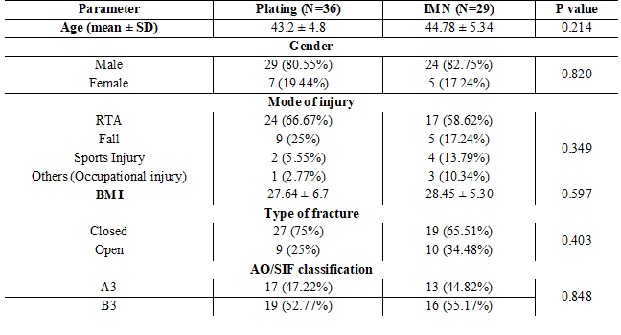A retrospective comparative study of intramedually nailing versus plating in the management of diaphyseal both-bone forearm fractures among adults
Abstract
Introduction: Aim was to compare the time taken for clinical and radiological union between intramedually nailing versus plating in the management of diaphyseal both-bone forearm fractures among adults.
Materials and Methods: This retrospective study compared two different procedures used as a part of routine care in treatment of both bones fractures of forearm. The functional outcomes were radiological union and range of motion. The fractures were stratified according to AO/SIF classification. The patients were assessed using the Grace-Eversmann criteria.
Results: A total of 65 participants were included in the study with 36 participants in plating and 29 in IMN group. The mean age in plating group was 43.2 ± 4.8 years and 44.78 ± 5.34 years in IMN group. There was no significant difference in the basic demographic characteristics between the groups. The mean time taken for radiological union in plating group andIMN group was 11.23 ± 2.16 weeks and 13.87 ± 3.32 weeks. There was a statistically significant differencebetween the groups with regard to mean operating time, radiological union and mean supination (P Value<0.05). In plating group, 27 (75%) participants had excellent, 6 (16.66%) participants had good and 3 (8.33%) participants had acceptable functional outcome. In IMN group, 23 (82.75%) participants had excellent, 4 (13.79%) participants had good, 1 (3.44%) participant had acceptable functional outcome and 1 (3.44%) participant had unacceptable functional outcome.
Conclusion: Radiological union was lesser and the range of motion was more for plating group. However, both modalities of treatment provided equally satisfactory results.
Downloads
References
2. Ambhore N, S B. A comparative study between plating & intramedullary nailing for displaced diaphyseal fractures of radius and ulna in adults. Int J surg Orthopedics. 2018;4(1):29-36.
3. Schulte LM, Meals CG, Neviaser RJ. Management of adult diaphyseal both-bone forearm fractures. J Am Acad Orthop Surg. 2014 Jul;22(7):437-46. doi: 10.5435/JAAOS-22-07-437.[pubmed]
4. Zhang XF, Huang JW, Mao HX, et al. Adult diaphyseal both-bone forearm fractures: A clinical and biomechanical comparison of four different fixations. Orthop Traumatol Surg Res. 2016 May;102(3):319-25. doi: 10.1016/j.otsr.2015.11.019. Epub 2016 Mar 5.[pubmed]
5. Henle P, Ortlieb K, Kuminack K, et al. Problems of bridging plate fixation for the treatment of forearm shaft fractures with the locking compression plate. Arch Orthop Trauma Surg. 2011 Jan;131(1):85-91. doi: 10.1007/s00402-010-1119-y. Epub 2010 Jun 3.[pubmed]
6. Lee YH, Lee SK, Chung MS, et al. Interlocking contoured intramedullary nail fixation for selected diaphyseal fractures of the forearm in adults. J Bone Joint Surg Am. 2008 Sep;90(9):1891-8. doi: 10.2106/JBJS.G.01636.[pubmed]
7. Visna P, Vlcek M, Valcha M, et al. [Management of diaphyseal forearm fractures using LCP angle- stable fixation devices and intramedullary nailing]. Rozhl Chir. 2009 Dec;88(12):708-15.[pubmed]
8. Thompson JE. Anatomical methods of approach in operations on the long bones of the extremities. Ann Surg. 1918 Sep;68(3):309-29.[puubmed]
9. Henry MH, Griggs SM, Levaro F, et al. Volar approach to dorsal displaced fractures of the distal radius. Tech Hand Up Extrem Surg. 2001 Mar;5(1):31-41.[pubmed]
10. Müller ME NS, Koch P, Schatzker, J. Classification AO des fractures.1987. Tome I. Les os longs. Berlin: Springer-Verlag. 1987.
11. Grace TG, Eversmann WW Jr. Forearm fractures: treatment by rigid fixation with early motion. J Bone Joint Surg Am. 1980 Apr;62(3):433-8.[pubmed]



 OAI - Open Archives Initiative
OAI - Open Archives Initiative


















 Therapoid
Therapoid

